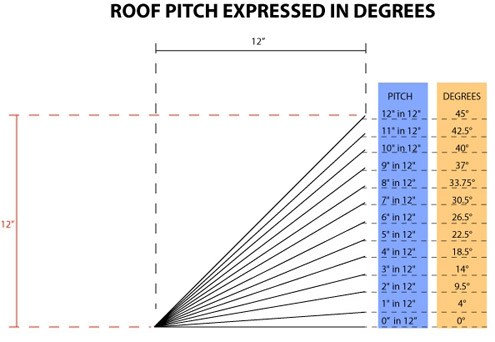If you are in the process of building a new home or replacing your roof, you may be wondering what the most cost-effective roof pitch is. The pitch of your roof plays a crucial role in determining its longevity, durability, and overall appearance, but it can also impact your budget. In this article, we’ll explore the factors that influence the cost of a roof pitch and provide insights on how to determine the most cost-effective option for your needs.

What Is the Most Cost Effective Roof Pitch?
When building a new home or replacing an old roof, one of the most critical decisions you’ll have to make is choosing the right roof pitch. The roof pitch, also known as the roof slope, refers to the angle at which the roof slopes. The roof pitch is essential because it determines how much weight the roof can support and how effectively water runoff. But, most importantly, it affects the cost of the roof. In this article, we will discuss the most cost-effective roof pitch and its benefits, so you can make an informed decision.
What is Roof Pitch?
Roof pitch is the measure of how much the roof rises vertically for every foot it runs horizontally. It is usually expressed in inches per foot or as a ratio of the rise over the run. For example, a roof with a 6/12 pitch means that the roof rises six inches vertically for every 12 inches it runs horizontally.
The roof pitch is determined by the architectural style, climate, and local building codes. The roof pitch can vary from low pitches of 1/12 to steep pitches of 12/12.
What is the Most Cost-Effective Roof Pitch?
The most cost-effective roof pitch is considered to be between 4/12 and 6/12. A pitch within this range is neither too steep nor too flat, making it ideal for most climates. The 4/12 and 6/12 pitches are also more common, so the materials and labor for the roof are more readily available and less expensive.
When the pitch is too steep, the cost of the roof increases due to the additional materials and labor required for installation. Similarly, a flat roof requires additional measures to manage water runoff, causing the cost to rise.
Benefits of a 4/12 to 6/12 Pitch Roof
A 4/12 to 6/12 pitch roof provides several benefits, including:
- Cost-effective: As mentioned earlier, a 4/12 to 6/12 pitch roof is the most cost-effective option. The materials and labor for this type of roof are readily available and less expensive than other roof pitches.
- Easy Maintenance: A roof with a pitch within this range is easier to maintain due to its accessibility. Cleaning gutters, checking for damage, and making repairs are easier to perform on a less steep roof.
- Energy Efficiency: A 4/12 to 6/12 pitch roof is considered energy-efficient as it allows for proper insulation and ventilation, reducing heating and cooling costs.
- Resale Value: A roof with a pitch within this range is considered a standard roof, making it easier to sell if you decide to put your home on the market.
4/12 vs. 6/12 Pitch Roof
While both a 4/12 and 6/12 pitch roof are cost-effective options, they have some differences.
A 4/12 pitch roof is ideal for areas that receive heavy rainfall or snow as it allows water and snow to run off quickly. It is also easier to install solar panels on this type of roof as they can be installed flush with the roof.
On the other hand, a 6/12 pitch roof is a better option for areas with high winds. The steeper pitch provides more stability against the wind, reducing the risk of damage to the roof. Additionally, a 6/12 pitch roof provides more space for an attic, adding value to your home.
Conclusion
When choosing the roof pitch for your home, consider the climate, local building codes, and cost. A 4/12 to 6/12 pitch roof is the most cost-effective option, providing several benefits, including easy maintenance, energy efficiency, and resale value. While a 4/12 pitch roof is better for heavy rainfall or snow, a 6/12 pitch roof is more stable against high winds and provides more attic space. Ultimately, the roof pitch you choose should meet your needs, preferences, and budget.
Frequently Asked Questions
What is roof pitch?
Roof pitch is the slope or angle of a roof. It is measured by the number of inches it rises vertically for every 12 inches it extends horizontally. A high pitch means the roof is steep, while a low pitch means it is shallow.
The pitch of a roof affects its style, functionality, and cost. Therefore, it is an important consideration when choosing a roofing system.
How does roof pitch affect cost?
The roof pitch affects the cost of a roofing project in several ways. First, a high pitch requires more materials and labor to install, making it more expensive than a low pitch. Second, a high pitch may require additional safety measures for installation, such as scaffolding or harnesses, which also add to the cost.
However, a high pitch can also have benefits, such as improved drainage and increased attic space, which may offset the higher cost in the long run.
What is the most cost-effective roof pitch?
The most cost-effective roof pitch depends on several factors, such as the size and shape of the roof, the climate, and the desired style. In general, a low pitch between 2/12 and 4/12 is the most cost-effective because it requires less material and labor to install.
However, a low pitch may not be suitable for certain roofing materials, such as slate or tile, which require a higher pitch for proper installation and performance.
Can roof pitch affect energy efficiency?
Yes, the roof pitch can affect the energy efficiency of a building. A steeper pitch can provide better ventilation and air circulation, reducing the need for air conditioning and improving indoor air quality. Additionally, a high pitch can allow for more insulation, which can help reduce energy costs by keeping the building warmer in the winter and cooler in the summer.
However, a high pitch can also increase the surface area of the roof, which can lead to more heat loss in the winter and more heat gain in the summer. Therefore, it is important to consider the climate and insulation needs when choosing a roof pitch for energy efficiency.
How do I determine the best roof pitch for my building?
The best roof pitch for your building depends on several factors, such as the climate, roofing materials, and building style. It is important to consult with a roofing professional who can assess your specific needs and recommend the most suitable pitch.
Additionally, you can consider factors such as the desired style, drainage needs, and energy efficiency goals when choosing a roof pitch. A roofing professional can help you weigh these factors and make an informed decision.
What Is The Most Common Roof Pitch – Home Building Questions And Answers
In conclusion, determining the most cost-effective roof pitch for your home or building is a crucial decision that can save you money in the long run. A flat roof may seem like the most economical option, but it can lead to costly repairs and maintenance. On the other hand, a steep roof pitch may increase the initial cost of installation, but it can provide significant benefits in terms of energy efficiency and durability.
When considering the best roof pitch for your needs, it’s important to take into account factors such as climate, local building codes, and the type of roofing material you plan to use. Additionally, consulting with a professional roofing contractor can help you make an informed decision and ensure that your roof is built to last.
Overall, while the most cost-effective roof pitch may vary depending on your specific circumstances, it’s essential to weigh the pros and cons of each option and choose the one that will provide the best long-term value for your investment.
